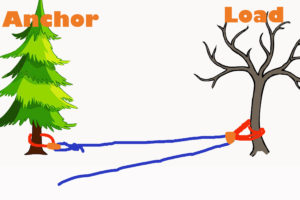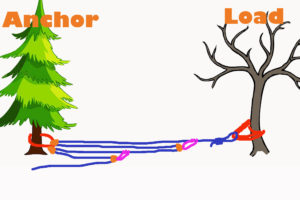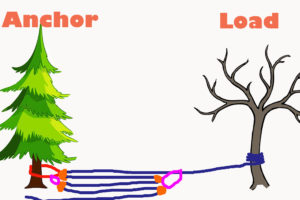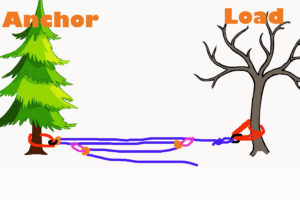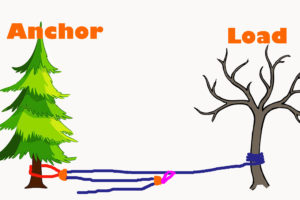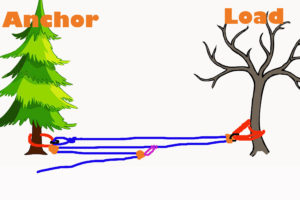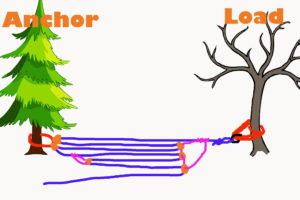Time to put on those thinking caps. I’ve drawn up a few sketches of mechanical advantage systems to test your brains today. Perhaps you’ve been following our #weeklyMA on facebook and twitter. If so, you’ll have a head start. In the sketches below, the anchor and load sides have been identified, pulleys are represented by the color orange, the hauling line is blue, anchors are red and prusik attachments are pink. Give your best guess as to the mechanical advantage generated in each sketch. Good luck. If you are stumped scroll down to the bottom for some hints followed by the answers.
Hopefully you never have set up some of the above systems. Why not? Because MA is a dangerous tool. You can quickly exceed the safety margins of the equipment in the system if you don’t properly understand the system you created and the power it has. As a rule, never exceed a 12:1 MA ratio. That means no more than 12 people pulling on a fixed rope, no more than 6 people hauling a 2:1, 4 and a 3:1 and so on. Have a good understanding of the simple MA systems; 1:1, 2:1, 3:1 and 4:1 pig rig. Are there times when you intentionally set up larger more complex systems? Perhaps, but ask yourself why and make sure you aren’t exceeding your limits.
Dont forget about two mandatory safety steps in any system.
1) Add a final change of direction at the anchor so your direction of pull keeps you out of the ‘line of fire.’ If there is failure it will travel in line with the load toward the anchor. The final change of direction keeps you further from harms way.
2) When possible attach a damper on the haul line as close to the load as possible. Should failure occur, this weighted damper will change the trajectory of the flying equipment, ideally it will hit the ground or water before it hits you.
Mechanical Advantage in review:
By itself, a pulley does nothing more than change direction and reduce friction. When utilized against an anchor or in conjuction with other pulleys Remember when calculating MA, you are calculating the advantage created on the load against the anchor. Pulleys that don’t move, do not create mechanical advantage. You can assume that pulleys attached to the anchor aren’t moving and thus don’t contribute to the mechanical advantage created with respect to the load.
A quick review of the three types of mechanical advantage:
Simple Mechanical Advantage: one or more pulleys travelling at the same speed in the same direction
Compound Mechanical advantage: two or more pulleys travelling in the same direction at different rates
Complex Mechanical advantage: Two or more pulleys travelling in the opposite direction at potentially different rates
Here’s a link that might help further your understanding of mechanical advantage:
http://www.ropebook.com/information/pulley-systems


